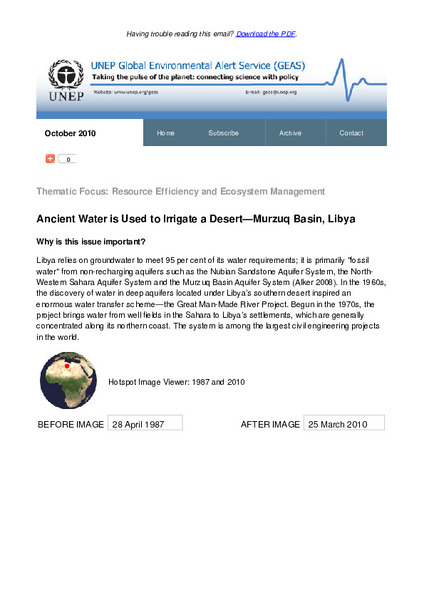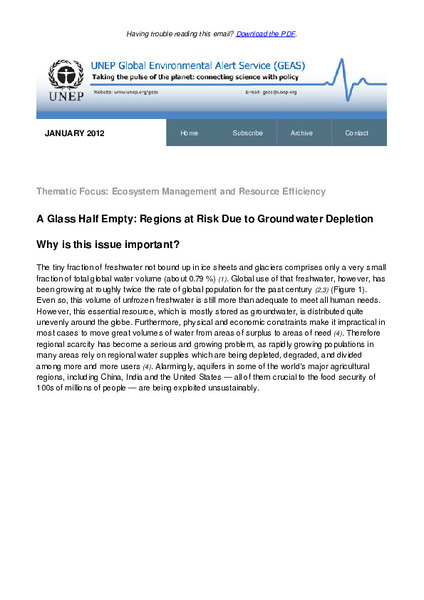Browsing Serials by SDGs "SDG 6 - Clean Water and Sanitation"
Now showing items 1-20 of 51
-
A New Eye in the Sky: Eco-drones: UNEP Global eEnvironmental Alert Service (GEAS) - May 2013
(2013)UNEP Global Environmental Alert Service (GEAS) is a mechanism for identifying, selecting and communicating early warning information on emerging issues to decision makers on a regular basis across UNEPs focus areas. The ... -
Ancient Water is Used to Irrigate a Desert—Murzuq Basin, Libya - UNEP Global Environmental Alert Service (GEAS) October 2010
(2010-10)Libya relies on groundwater to meet 95 per cent of its water requirements; it is primarily "fossil water" from non-recharging aquifers such as the Nubian Sandstone Aquifer System, the North-Western Sahara Aquifer System ... -
Balancing economic development and protecting the cradle of mankind - Lake Turkana basin: UNEP Global Environmental Alert Service (GEAS) - June 2013
(2013)A number of transboundary water agreements exist in Africa. However, many of these agreements are limited to larger basins such as the Nile, Niger, Senegal or Volta. There are very few international river basin agreements ... -
Cyclone Phailin in India: Early Warning and Timely Actions Saved Lives: UNEP Global Environmental Alert Service (GEAS) - November 2013
(2013)This issue focuses on the lessons learned from Cyclone Phailin and how they can be applied to other disasters such as the recent Typhoon Haiyan. -
The Faith We Share and The World We Want - UNEP Perspectives No. 21
(2016-04)Successful implementation of the 2030 Agenda for Sustainable Development will require healthy, resilient and sustainable local communities everywhere. Focusing on the health, resilience and sustainability of local communities ... -
Forecasting and Early Warning of Dust Storms: UNEP Global Environmental Alert Service (GEAS) - February 2013
(2013)Dust storms can have high interannual, as well as annual and decadal, variability, thus it is important that more research is conducted over longer periods of time to analyze trends and associated storm severity. With ... -
From Hotspots to Hopespots: Connecting Local Changes to Global Audiences: UNEP Global Environmental Alert Service - July 2013
(2013)As changes to ecosystems and the environment continue to occur in response to growing population pressure and natural processes, ways to measure and observe these changes on a regular basis will become increasingly important. ... -
Gender and Environment: Empowering Rural Women: Access to Land and Natural Resources - SDG Policy Brief No. 002
(2018)Women constitute approximately half of the rural labour force and are economically active in each subsector of the rural economy. Their livelihoods are often based on access to and control over natural resources. The ... -
GEO Matters - July 2018
(2018-07)This issue features key GEO-related events including the First GEO for Youth authors meeting held in Bangkok on 25-27 June 2018, and the Meeting of the Policy Effectiveness Authors of the sixth edition of the Global ... -
GEO Matters - March 2019
(2019-03)The sixth edition of the Global Environment Outlook which is the most comprehensive and rigorous assessment on the state of the environment completed by the United Nations in the last five years was published on 13 March ... -
GEO Matters - October 2020
(2020)The GEO for Cities on 9th October 2020 held a successful event at Daring Cities 2020 titled ‘vision and pathway related to circular cities’. Daring Cities is a virtual, action-oriented forum to recognize and empower ... -
GEO Matters August 2018
(2018-08)The Global Environment Outlook (GEO) is a consultative and participatory process to prepare an independent assessment of the state of the environment, the effectiveness of the policy response to address these environmental ... -
GEO Matters August 2021
(31/08/2021)The still unfolding effects of the COVID-19 global health pandemic has presented humankind with new challenges, emphasized fundamental truths and enhanced need for critical review of human interaction with nature. For ... -
GEO Matters February 2021
(2021)The ‘Adapt to Survive: Business transformation in a time of uncertainty’ brief is the first in a series of six GEO for Business Briefs published by the United Nations Environment Programme (UNEP) to better inform, engage ... -
GEO Matters November-December 2020
(United Nations Environment Programme, 2020-12)The Technical Summary had a successful launch on 17th December 2020. The Technical Summary of GEO-6 distills the science and data in the main report and synthesizes the information to make it more accessible to students ... -
A Glass Half Empty: Regions at Risk Due to Groundwater Depletion - UNEP Global Environmental Alert Service (GEAS) January 2012
(2012-01)The tiny fraction of freshwater not bound up in ice sheets and glaciers comprises only a very small fraction of total global water volume (about 0.79 %) (1). Global use of that freshwater, however, has been growing at ... -
Human health and the environment : UNEP Post 2015 Note 3
(2014)Ensuring a clean and healthy environment, through effective environmental management, will provide multiple benefits to society and the economy. -
Integrating the three dimensions of sustainable development : How to achieve a balanced, ambitious and inclusive framework : UNEP Post 2015 Note 1
(2014)Growth and prosperity are being achieved at the expense of the planet’s life support systems, and at the expense of greater inequality. Disasters are reversing development gains. The three dimensions of sustainable development ... -
Integration and universality key to post-2015 sustainable agenda : UNEP Post 2015 Note 8
An unprecedented series of decisions by governments since the 2012 Rio+20 conference has yielded progress towards a universal commitment to achieve sustainable development. The year 2015 will see additional efforts to ... -
Korea Environmental Policy Bulletin - Conservation and Sustainable Use of Biological Resources
(Ministry of Environment - Korea Environment Institute - Republic of Korea, 2010)After the recognition of national ownership of biological resources pursuant to the Convention on Biological Diversity (CBD), competition between nations has been intensifying to acquire biological resources. The Korean ...





















